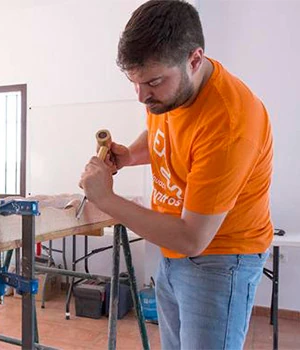
BIO
Álvaro Albaladejo (Granada, 1983) studied a degree in Fine Arts (University of Granada, 2008) as well as at the Akademie der Bildenden Künste in Munich (2006-2007).
Amongst his different solo exhibitions, the following stand out: ‘Midnight after the desert’ (Sala Santa Inés, Seville 2020, arranged through the ‘Iniciarte’ program); ‘Mirage in Greenland’ (Artnueve Gallery, Murcia, 2020); ‘Movement of the Spectrum’ (Marta Gualda Artifacts, Charlotte, North Carolina, USA 2019); ‘The Well and the Pyramid’, with Cristina Ramírez (Fundación BilbaoArte Fundazioa, Bilbao, Spain, 2019); ‘The End of the Universe’ (Sala Zaida, Granada, 2018); ‘Vueltas y penumbras’ (Sala PTS, Granada, 2017); ‘The Eye and the Vortex’ (Sala Ático, Palacio de los Condes de Gabia, Granada, 2016).
He has joined many group exhibitions amongst which are: ‘Calculation error’ (Rafael Botí Foundation, Córdoba, 2021); ‘Fictions’ (Iglesia San Esteban, Murcia, 2021); ‘Contained Form’ (Isabel Hurley Gallery, Málaga, 2021); ‘Between the Forms That Go Towards the Serpent and the Forms that Look For the Glass’ (Andalusian Center of Contemporary Art, CAAC, Seville 202) and ‘Atavistic Memory’ (SCAN Spanish Contemporary Artist Network, London, 2019).
He has been an artist-in-residence for The Bilbaoarte Fundazioa Foundation (Bilbao); The Contemporary Creation Centre of Andalusia-C3A (Córdoba); The Genalguacil Pueblo Museo (Málaga) or for Valparaíso Foundation (Almería). He has also exhibited in art fairs such as: Arco, Estampa and Swab with Galería Artnueve. He works on sculpture and installation mainly. He currently lives and works in Córdoba.
ARTWORK
Through a series of hallucinatory technologies, Albaladejo pushes perception further its limits. To attack the eye, the artist introduces a series of devices into his sculptures that alter the perception of the artwork, which cause not only strangeness but experiences close to vertigo and disorientation.
In his artworks, Albaladejo’s primary focus on the physical aspect of vision stems from the underground tradition of modernist art that goes from psychedelia to experimental cinema. This trend postulates that there is no neutral position from which to approach the visual, but rather the lack of disturbance that a distanced observation entails is historically conditioned. Hence, this radical critique of the retinal operates through the confrontation and subversion of the normalized visual experience.
The eye submerges into Albaladejo’s sculptures, fascinated by the weave of spectral forms and optical effects. Thus, besieged by paradoxes and contradictions, the gaze wrecks and, in the vertigo of the fall, the very act of seeing becomes subject.
The artwork that he presents for DinA3 is not far from his sculptural work. It is a run of sixty risograph copies in metallic gold ink. Ultimately, what the author shows by exploding the visual is the fragile border that separates material from psychic reality.
The image is inspired by an author’s digital photograph in the Irati forest in summer 2021. The composition, the alteration through digital treatment, and the ink reflections result in an ambiguous reading of the image, which moves into the liminal realm between the abstract and the figurative.
The forest mannequin images by Hans Bellmer or the series of photographs by T. R. Ericsson on Duchamp’s ‘Étant donnés’ (1946-1966) are key references. In these, landscape works as an interior place, a psychological and emotional state where an essence manifests to remind us that certain places are only accessed without being present. They are seen without eyes or inhabited without living.


